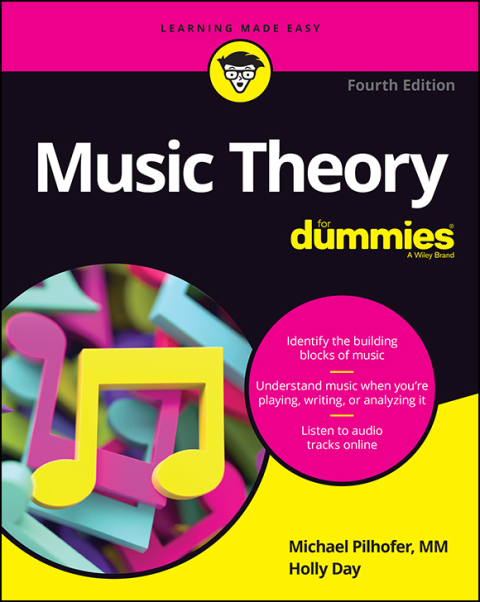Description
Efnisyfirlit
- Cover
- Introduction
- About This Book
- Foolish Assumptions
- Icons Used in This Book
- Beyond the Book
- Where to Go from Here
- Part 1: Getting Started with Music Theory
- Chapter 1: What Is Music Theory, Anyway?
- Unearthing Music Theory’s Beginnings
- Putting the Spotlight on Music Theory Fundamentals
- Seeing How Theory Can Help Your Music
- Chapter 2: Determining What Notes Are Worth
- Meeting the Beat
- Recognizing Notes and Note Values
- Checking Out Whole (Semibreve) Notes
- Homing in on Half (Minim) Notes
- Considering Quarter (Crotchet) Notes
- Examining Eighth (Quaver) Notes and Beyond
- Extending Notes with Dots and Ties
- Mixing All the Note Values Together
- Chapter 3: Giving It a Rest
- Getting to Know the Rests
- Extending the Break with Dotted Rests
- Practicing Beats with Notes and Rests
- Chapter 4: Introducing Time Signatures
- Decoding Time Signatures and Measures
- Keeping Things Easy with Simple Time Signatures
- Working with Compound Time Signatures
- Feeling the Pulse of Asymmetrical Time Signatures
- A Short Discussion about Conducting
- Chapter 5: Playing with Beat
- Creating Stress Patterns and Syncopation
- Getting a Jump on Pick-Up Notes
- Exploring Irregular Rhythms: Triplets and Duplets
- Part 2: Putting Notes Together
- Chapter 6: Music Notes (and Where to Find Them)
- Meeting the Staff, Clefs, and Notes
- Identifying Half Steps, Whole Steps, and Accidentals
- Finding the Notes on the Piano and the Guitar
- Using Mnemonics to Help Remember Notes
- Chapter 7: Mastering the Major and Minor Scales
- Following Major-Scale Patterns
- Discovering All That Minor Scale Patterns Have to Offer
- Chapter 8: Key Signatures and the Circle of Fifths
- Understanding the Circle of Fifths and Recognizing Major Key Signatures
- Finding Minor Key Signatures and Relative Minors
- Visualizing the Key Signatures
- Chapter 9: Intervals: The Distance between Pitches
- Breaking Down Harmonic and Melodic Intervals
- Looking at Unisons, Octaves, Fourths, and Fifths
- Recognizing Seconds, Thirds, Sixths, and Sevenths
- Building Intervals
- Showing Major and Perfect Intervals in the C Major Scale
- Checking Out Compound Intervals
- The Nashville Number System
- Chapter 10: Chord Building
- Creating Triads with Three Pitches
- Expanding to Seventh Chords
- Looking at All the Triads and Sevenths
- Manipulating Triads through Voicing and Inversion
- Exploring Extended Chords
- Chapter 11: Chord Progressions
- Reviewing Diatonic Chords, Chromatic Chords, and Minor Scale Modes
- Identifying and Naming Chord Progressions
- Adding a Seventh Chord to a Triad
- Seeing (and Hearing) Chord Progressions in Action
- Applying Chord Knowledge to Fake Books and Tabs
- Modulating to a New Key
- Reaching a Musical Cadence through Chord Progressions
- Part 3: Musical Expression through Tempo and Dynamics
- Chapter 12: Creating Varied Sound through Tempo and Dynamics
- Taking the Tempo of Music
- Dealing with Dynamics: Loud and Soft
- Chapter 13: Instrument Tone Color and Acoustics
- Delving into Tone Color
- Building the Band: An Acoustics Lesson
- Part 4: Musical Expression through Form
- Chapter 14: The Building Blocks of Music: Rhythm, Melody, Harmony, and Song Form
- Establishing Rhythm
- Shaping the Melody
- Complementing the Melody with Harmony
- Working with Musical Phrases and Periods
- Linking Musical Parts to Create Forms
- Chapter 15: Relying on Classical Forms
- Counterpoint as a Classical Revelation
- Sussing Out the Sonata
- Rounding Up the Rondo
- Figuring Out the Fugue
- Combining Forms into a Symphony
- Observing Other Classical Forms
- Chapter 16: Tapping into Popular Genres and Forms
- Feeling the Blues
- Having Fun with Rock and Pop
- Improvising with Jazz
- Twelve-Tone Compositions
- Part 5: The Part of Tens
- Chapter 17: Ten Frequently Asked Questions about Music Theory
- Why Is Music Theory Important?
- If I Can Already Play Some Music, Why Bother Learning Music Theory?
- Why Is So Much Music Theory Centered on the Piano Keyboard?
- Is There a Quick and Easy Way to Learn to Read Music?
- How Do I Identify a Key Based on the Key Signature?
- Can I Transpose a Piece of Music into Another Key?
- Will Learning Music Theory Hinder My Ability to Improvise?
- Do I Need to Know Theory if I Just Play Drums?
- Where Do the 12 Musical Notes Come From?
- How Does Knowing Theory Help Me Memorize a Piece of Music?
- Chapter 18: Ten Keys to Reading a Musical Score
- The Basics
- Lead Sheets
- Full Scores
- Miniature Scores
- Study Scores
- Piano Scores
- Short Scores
- Vocal Scores
- Tablature
- Figured Bass Notion
- Chapter 19: Ten Music Theorists You Should Know About
- Pythagoras (582–507 BC)
- Boethius (480–524 AD)
- Gerbert d’Aurillac/Pope Sylvester II (950–1003)
- Guido D’Arezzo (990–1040)
- Nicola Vicentino (1511–1576)
- Christiaan Huygens (1629–1695)
- Arnold Schoenberg (1874–1951)
- Harry Partch (1901–1974)
- Karlheinz Stockhausen (1928–2007)
- Robert Moog (1934–2005)
- Chapter 20: Ten Musical Movements That Changed History
- 800 AD — England, Gregorian Chant
- 1100 AD — Organum/European Polyphony
- 1649 — England, the Diggers
- 17th Century: Italy, Opera
- 1789-1799: The French Revolution
- 1913 — Atonal Music and Igor Stravinsky’s “The Rite of Spring”
- 1950-1990: Latin America and the Iberian Peninsula, “Nueva Canción” (the New Song Movement)
- 1960s: U.S. Civil Rights Movement
- 1980s: Estonia Singing Revolution
- 2010-2012: Arab Spring
- Part 6: Appendixes
- Appendix A: Audio Tracks
- Appendix B: Chord Chart
- Appendix C: Glossary
- Index
- About the Authors
- Connect with Dummies
- End User License Agreement





